As far as National Park Service passport cancellation stamps go, the one I'm given at Theodore Roosevelt Inaugural National Historic Site is historically significant. “Sep 14 2024,” it reads. “Buffalo, NY.”
I’ve come to the site on the 123rd anniversary of the day that Roosevelt was sworn in as president in a private home wearing a borrowed frock coat. The only presidential inaugurations that have taken place outside of the Capitol Building in Washington, D.C. since 1801 involve a president being assassinated or dying.
That was the case when President William McKinley was shot twice by Polish-American anarchist Leon F. Czolgosz on September 6, 1901 during the Pan-American Exposition. He seemed like he would pull through but then died September 14. Roosevelt, who had been climbing Mount Marcy in the Adirondacks when he learned that McKinley wasn’t expected to survive, raced back by train.
He didn’t make it before McKinley’s 2:15 a.m. death, and the nation was without a president for more than 13 hours. The vice president paid his respects to McKinley’s widow before being sworn in as the 26th president of the United States just after 3:30 p.m. in the home of lawyer Ansley Wilcox, a friend and fellow political reformer.

In the library of the Buffalo home where Theodore Roosevelt was sworn in as president, the borrowed frock coat that he wore is on temporary loan from the Buffalo History Museum/Jennifer Bain
District Judge John R. Hazel administered the oath before six of eight cabinet members and other witnesses in the home’s library. Roosevelt didn’t allow any pictures to be taken during the brief and improvised ceremony, but the empty room was photographed later that somber day. He wore a long frock coat, trousers, waistcoat, four-in-hand tie, and patent leather shoes borrowed from his friend.
“Roosevelt was very insistent that it should be a private ceremony out of respect for McKinley,” says Mark Lozo, education director for the non-profit foundation that runs the site. “So rather than go to a place like city hall they went with a private ceremony. He insisted, though, that the (John) Milburn home where McKinley had died would be disrespectful, so the Wilcox home was chosen as the location where the inauguration would take place.”
In the library, I study the frock coat on a mannequin that's correct to Roosevelt’s stature. In a strange theme of "borrowed things" that runs through this site's story, the coat is on loan from the Buffalo History Museum for the inauguration anniversary, although there’s talk of having a duplicate manufactured during next year’s conservation assessment period.

On Buffalo's Delaware Avenue, a statue of President Theodore Roosevelt stands on the lawn outside Theodore Roosevelt Inaugural National Historic Site/Jennifer Bain
The stately Greek Revival house, at 641 Delaware Avenue, continues to insert itself into American politcal history.
Now a unit of the National Park Service, the site is managed by a local board of trustees — the Theodore Roosevelt Inaugural Site Foundation — through a cooperative agreement with the NPS.
“We’re an anomaly in the NPS,” allows Spencer Morgan, who took over as executive director on April 1. “We receive one-third of our budget from the NPS. We are charged with raising a little over two-thirds of the budget.”
The NPS owns the house and property and helps with cyclic maintenance grants. The foundation operates the site and owns the collections and exhibits. It raises money through entrance fees (although it accepts annual America the Beautiful passes), events, donations, grants, rentals and gift shop sales.

At the Buffalo History Museum, you can see the revolver used to assassinate President William McKinley and the handkerchief used to hide it at a Pan-American Exposition public reception/Jennifer Bain
My Sept. 14 visit is for an inauguration anniversary event that lasts four hours and includes a double-decker bus tour to spots connected to McKinley’s death and the start of Roosevelt’s presidential legacy.
But if you’ve heard about Theodore Roosevelt Inaugural this year, it’s probably because of its ties to an unsolved crime.
A silver pocket watch that traveled the world with Roosevelt during his presidency was famously stolen from a display case here in 1987 while on loan from the NPS. After nearly four decades, it has now been recovered thanks to NPS special agents and the FBI.
In June, NPS Director Chuck Sams, Roosevelt family members and NPS staff gathered at Sagamore Hill National Historic Site on Long Island to celebrate the watch’s return. They revealed that it had turned up in a Florida auction house that contacted the Park Service about its authenticity.
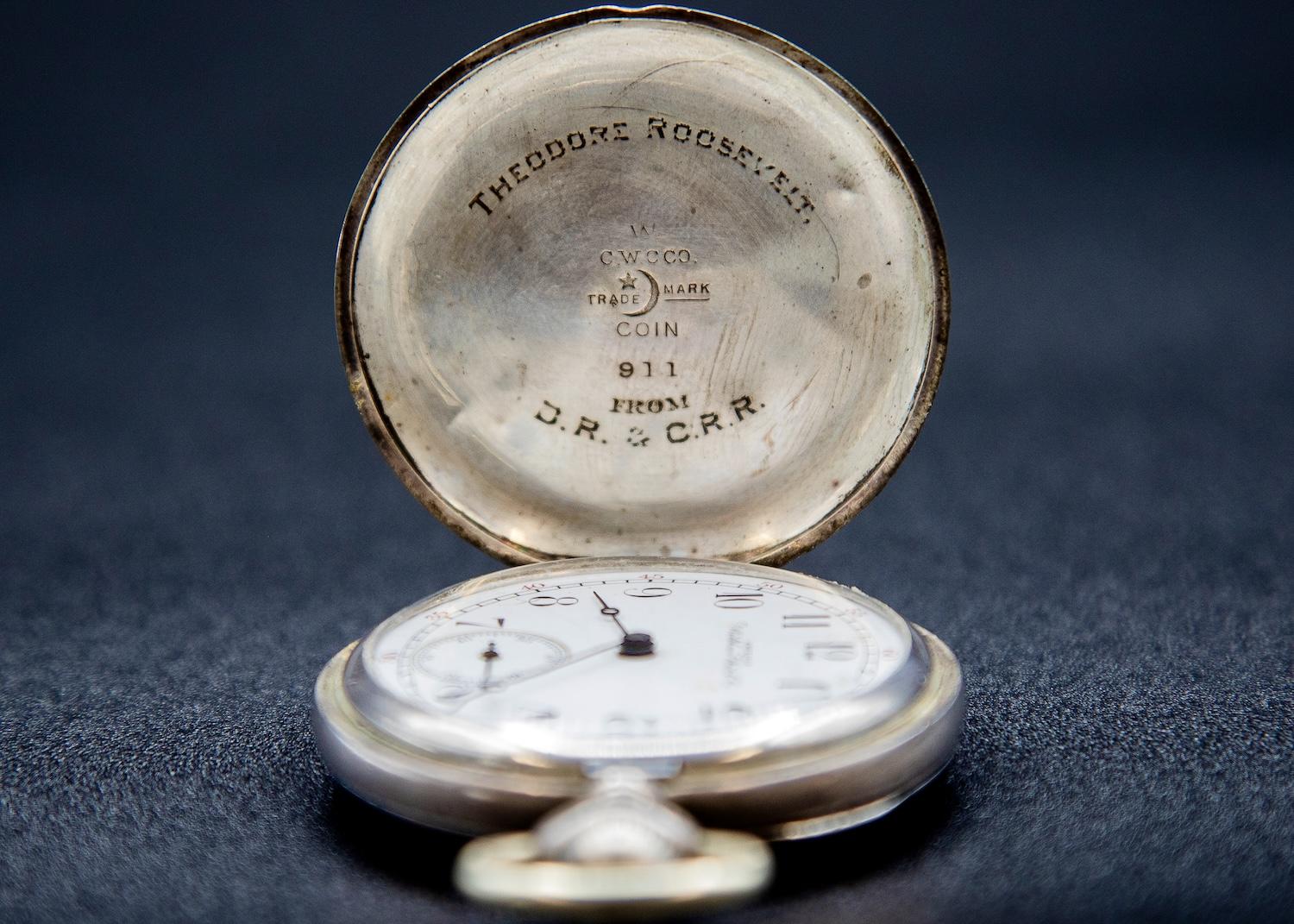
A pocket watch belonging to Theodore Roosevelt, stolen while on loan to the Theodore Roosevelt Inaugural site in Buffalo, has been recovered and returned to Sagamore Hill National Historic Site on Long Island/NPS Photo
What they didn’t specify was the auction house had reached out to Theodore Roosevelt Inaugural site with images of the timepiece, and Morgan's predecessor alerted Sagamore Hill and the NPS.
“It’s still an active investigation and we don’t know if we’ll ever know who stole it, why or when,” says Morgan, adding that he was only a year old when the devastating theft happened. Still, it was a thrill to be invited to the Sagamore Hill ceremony to speak about his site’s role in the saga.
People who were at the Buffalo site during the theft were broken-hearted about it, he says. “For it to come full circle, it was our own little National Treasure story.”
The watch will remain in the permanent museum collection of Sagamore Hill where it’s currently on display. Truth be told, it isn’t part of the Roosevelt inauguration story and was only borrowed to drum up attention. Morgan did however see a “cute pocket watch with Roosevelt’s face” at the Sagamore Hill gift shop and hopes to sell the same one in his gift shop as a way to tell this intriguing side story.
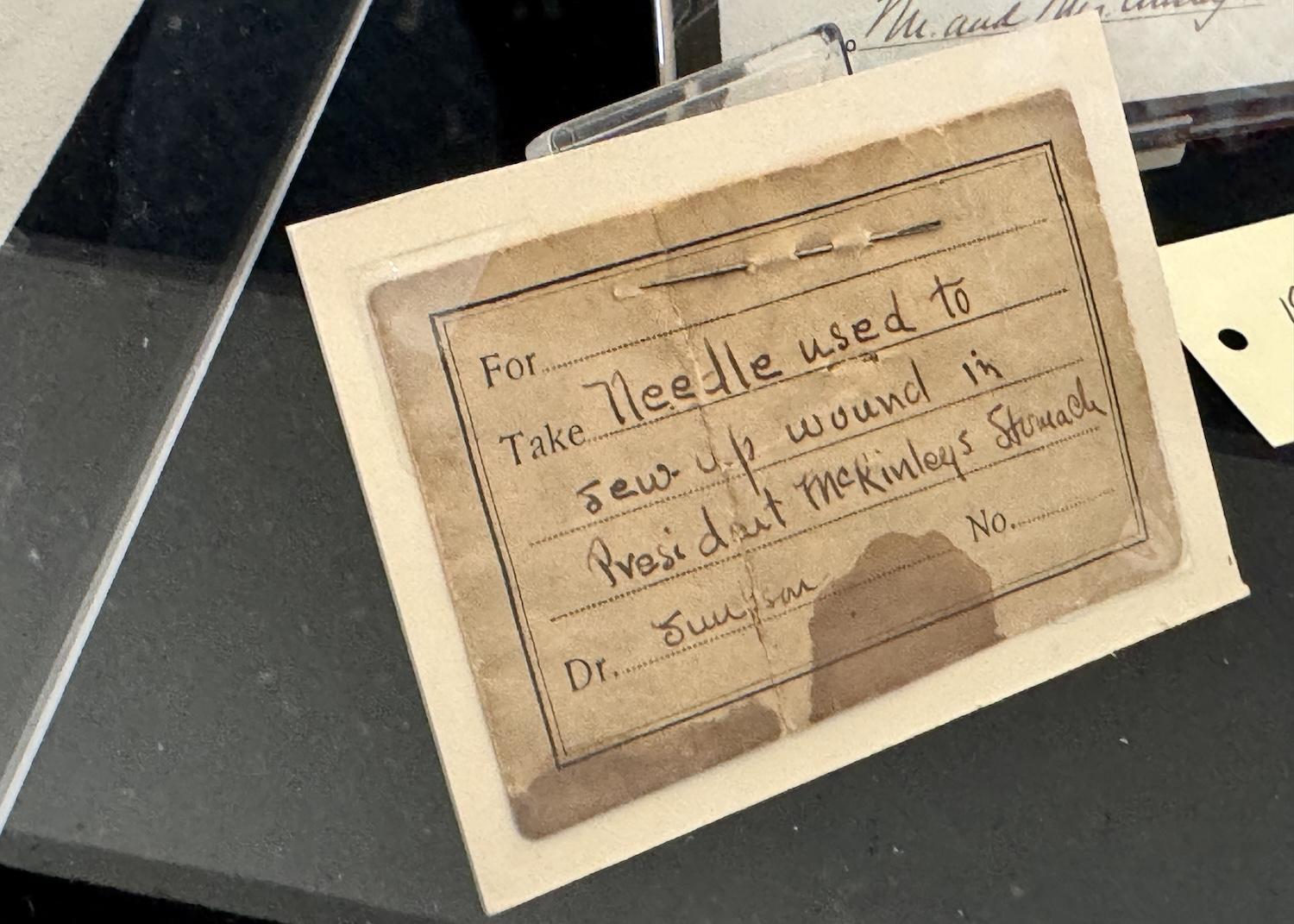
To celebrate the anniversary of President Theodore Roosevelt's inauguration, a needle used during the operation on President William McKinley was put on display for a few hours in Buffalo/Jennifer Bain
“Only 10 percent of the museum’s collection is on display at one time,” he points out.
Today, collections manager Amy Sanderson has pulled out a few special things to show visitors, including a tiny needle that was used to sew up McKinley’s stomach. It’s in a brown envelope that was used to dispense pills and bears the name of a local medical student who worked at the Pan-Am hospital where McKinley underwent emergency surgery.
The needle isn’t usually on display because it relates to the shooting and not the inauguration. “Virtually all of our collection comes in through donations,” says Sanderson. “It’s just things that people have kept through the years and think should be in the public realm.” Two of the site’s major collections are available online, she adds.

At the Buffalo History Museum, you can see a photo of the man who assassinated President William McKinley and the handcuffs police put on him/Jennifer Bain
Open daily, the inaugural site gets a respectable 30,000 visitors a year. What’s fun about the double-decker bus tour (an event that happens several times a year) is that it tells the broader story, stopping at the Buffalo History Museum to see the assassin’s gun and the handkerchief he hid it under, driving by what’s left of the places where McKinley underwent surgery and later died, and stopping by the McKinley Monument in front of Buffalo City Hall.
Bus tours always end back on Delaware Avenue, where a visitor center in a reconstructed carriage house opens into the famous house that has been reconfigured as a museum.
The house itself, I learn, was likely originally built around 1839-40 as officer headquarters for a U.S. Army installation called Poinsett Barracks or Buffalo Barracks. By 1845, it was transformed into the first of a series of private residences.
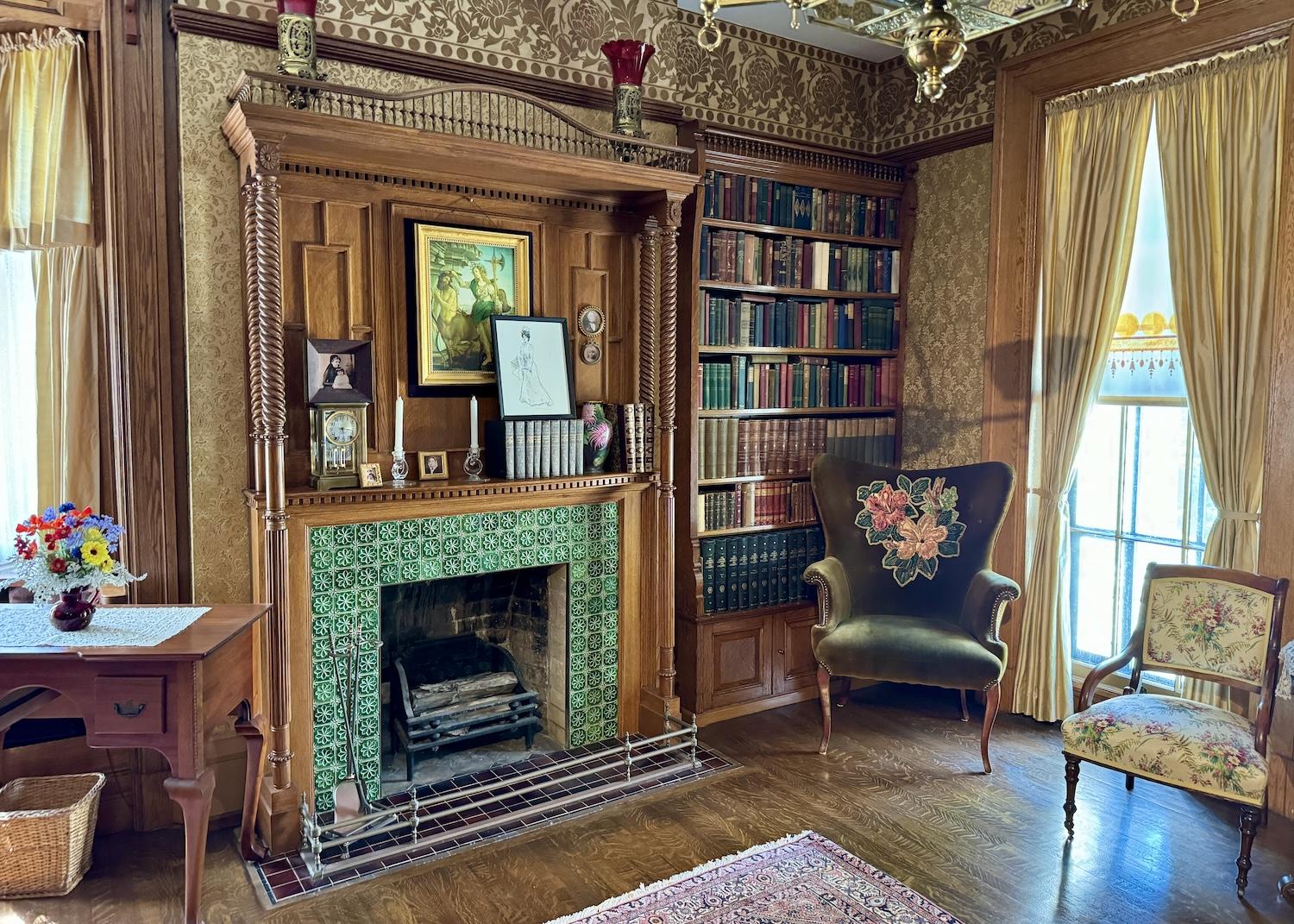
The books at this end of the library were salvaged from the Wilcox era. The clock on the fireplace mantle is set to the time of President Theodore Roosevelt's inauguration/Jennifer Bain
After the Wilcox family passed on, the furnishings were auctioned off. A campaign led by the Spanish American War Veterans to establish the house as the Theodore Roosevelt Institute for Better Citizenship failed, and the house was sold. At some point, sharp-eyed neighbors salvaged some of the library’s original books from the garbage when the property was being renovated and later donated them to the foundation. (Those are at one end of the reconstructed library.)
For a few decades, the storied house was Kathryn Lawrence’s Dining Rooms. But as commercial development along Delaware Avenue threatened the home’s survival, a campaign was launched to preserve it and the property was declared a National Historic Site by congressional law in 1966. It opened as a public museum on September 14, 1971.
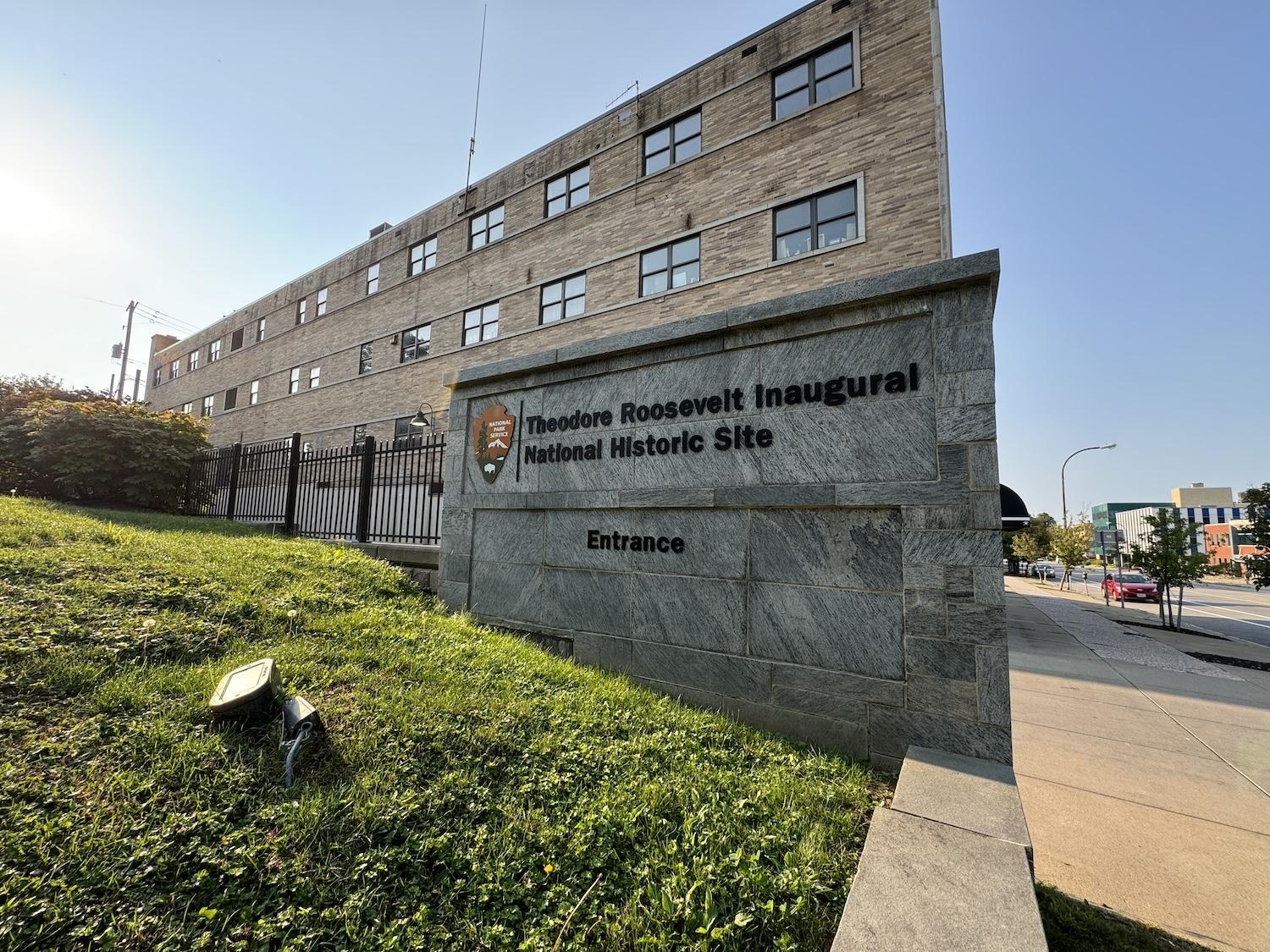
Theodore Roosevelt Inaugural NHS is on busy Delaware Avenue in Buffalo/Jennifer Bain
Theodore Roosevelt Inaugural is one of six Roosevelt-related NPS sites. The others are Sagamore Hill in Oyster Bay, Theodore Roosevelt Birthplace National Historic Site in New York City, Theodore Roosevelt National Park in North Dakota, Theodore Roosevelt Island in D.C. and Mount Rushmore National Memorial in South Dakota.
To set the scene for the September 1901 inauguration during Buffalo's heyday, guided tours explain how the Pan-Am Expo attracted eight million people (including the president and vice-president) over six months.
Spread over 350 acres, the expo celebrated industrial, cultural and technological progress and was the first event to showcase the large-scale use of electricity to illuminate buildings at night. In an eerie twist, the self-described anarchist who shot the president while he was shaking hands with the public during a Pan-Am reception was sentenced to death by electrocution.
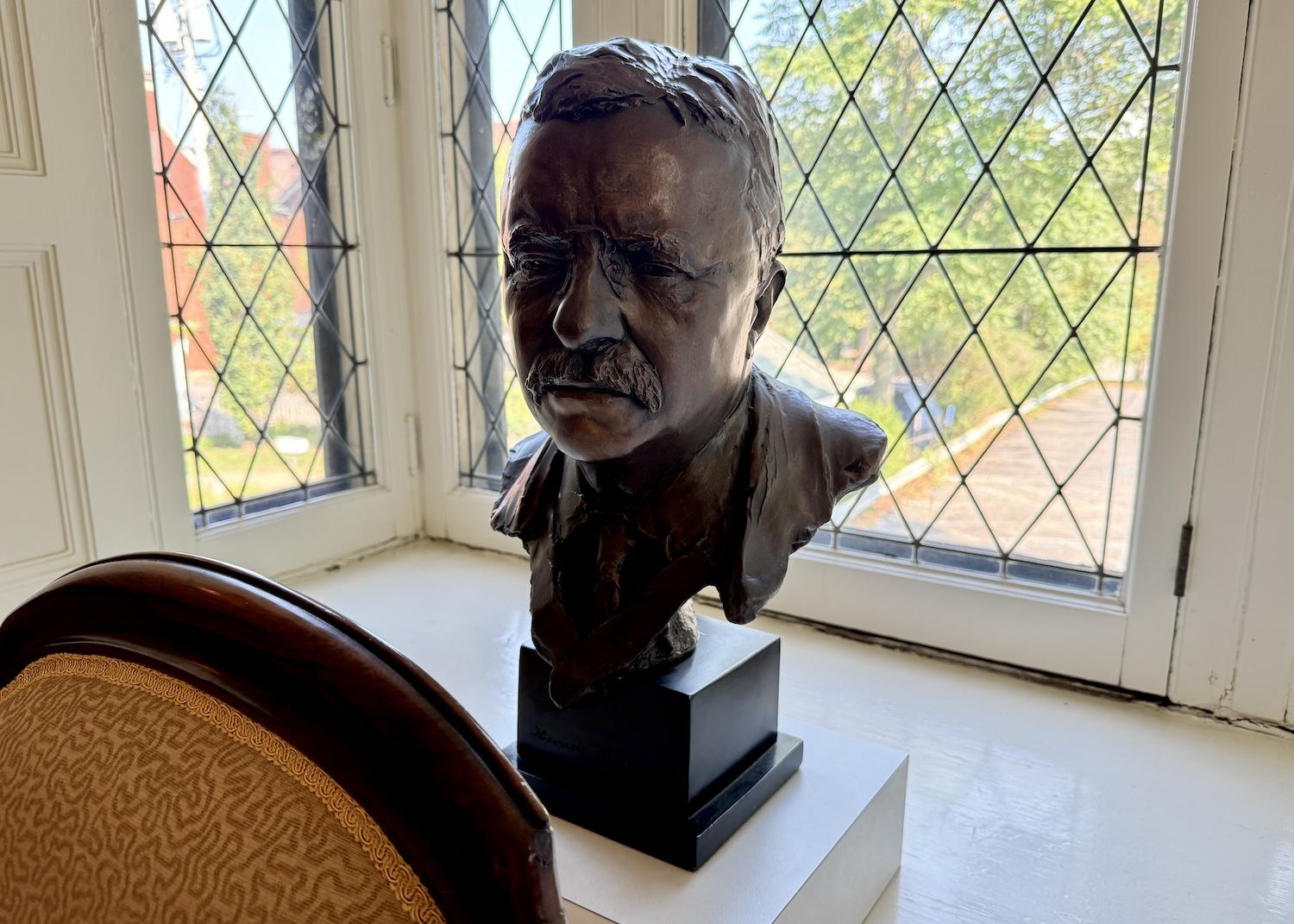
A bust of President Theodore Roosevelt sits in the window of one of the restored rooms/Jennifer Bain
That macabre fact aside, the site explains the historic events surrounding the unusual inauguration, and fosters discussion of Roosevelt, his presidency and his legacy of creating protections for ordinary citizens, beginning regulation of big business, and making the U.S. a major force in international affairs.
“(Roosevelt) did issue his first presidential proclamation from this house, and that was to usher the country into a period of mourning,” says Morgan. The new president also sent a note to African-American educator/author Booker T. Washington on September 14, 1901, canceling a dinner at Tuskegee Institute in Alabama and saying they must talk soon. Washington later dined at the White House, a scandal at the time.
“We can lay claim to the fact that Roosevelt was thinking about race and social justice when he was taking the oath of office here at 641 Delaware Avenue 123 years ago today,” Morgan proudly says.
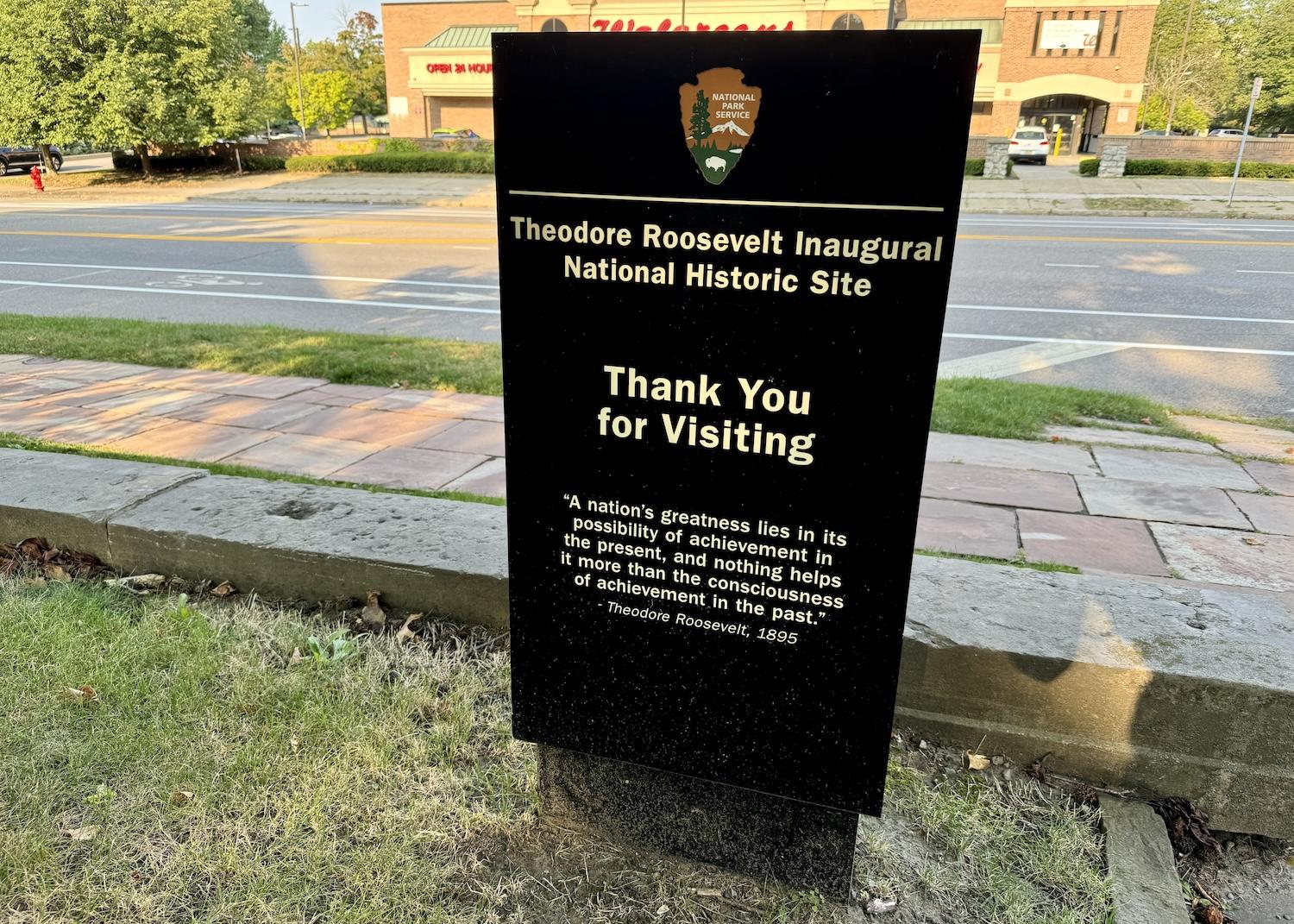
Theodore Roosevelt Inaugural NHS shares some of the president's famous quotes with those who walk by on Delaware Avenue/Jennifer Bain
The new executive director has plenty of plans to draw more visitors, including rebuilding the historic home’s planters and filling them with elephant ears that archival photos show were here on inauguration day back at the end of the Gilded Age.
A week after Morgan came aboard, the site was on the path of totality that crossed 27 park units. I wasn't there that day but am belatedly offered that passport cancellation stamp, too: "Time of Totality: 3:18:21 PM," it reads. "April 8, 2024. Total Solar Eclipse."
On October 1, the site’s new five-year cooperative agreement with the NPS begins. On October 26, it will be a voter registration station and early polling station for the upcoming presidential election. “So people can come and vote for president here,” says Morgan with delight. “And it’s worth noting that October 27 is Theodore Roosevelt’s birthday.”

Spencer Morgan is the new executive director of the Theodore Roosevelt Inaugural site/Jennifer Bain



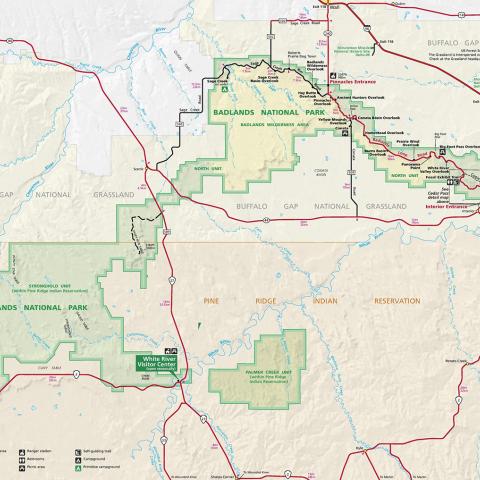
 Support Essential Coverage of Essential Places
Support Essential Coverage of Essential Places






